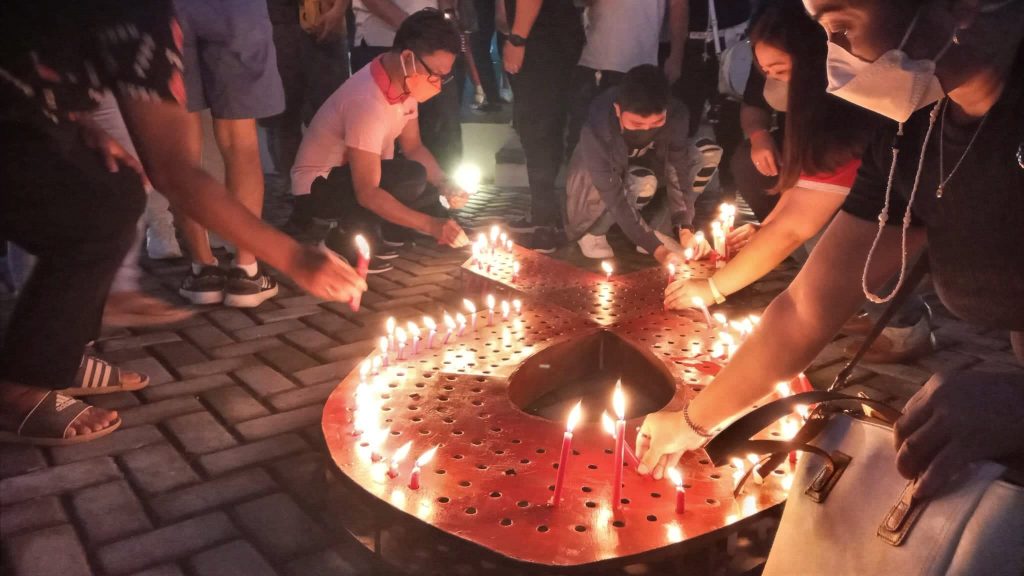
SILENT EPIDEMIC. Advocates and government employees light candles at the city amphitheater in Cagayan de Oro City during the International AIDS Candlelight Memorial on May 15, 2022. In one of its reports, the US National Center for Biotechnology Information said “HIV crisis in the Philippines has worsened during the COVID-19 pandemic”. (Jigger Jerusalem/davaotoday.com)
CAGAYAN DE ORO CITY, Philippines — The human immunodeficiency virus (HIV) has become a “silent epidemic” at the time when the country battles with Coronavirus Disease 2019 (COVID-19).
Fritizie Estoque, vice president of the Misamis Oriental Cagayan de Oro AIDS Network (Mocan), said they are alarmed that HIV-AIDS (acquired immunodeficiency syndrome) has been overshadowed when a national health emergency was declared by the government due to the pandemic in 2020. Since then, information campaign by health service providers and their allies in the private sector was not prioritized.
“In the midst of the pandemic we do not stop with what we have to do because HIV is still threatening us, still claiming lives. It should not have been the case,” she explained in an interview Monday, May 16.
Even with the concerted efforts to reduce the number of COVID-19 cases, she said the HIV information and education campaign must be sustained.
“No pandemic, no quarantine, no lockdown can stop the spread of HIV, especially during the pandemic that there was no education conducted, and our youth have not been reminded to keep themselves safe. Condoms were no longer being handed out close to two years. We have monitored that,” she shared.
HIV is a virus that attacks the immune system while AIDS is a term that can only be used when HIV has caused severe damage to the immune system.
The spread of HIV remains a serious concern among groups offering interventions to people living with HIV (PLHIV), Estoque said.
Worsening crisis
In one of its reports, the US National Center for Biotechnology Information said the “HIV crisis in the Philippines has worsened during the COVID-19 pandemic.”
It added the country’s Department of Health (DOH) reported that HIV testing decreased by 61 percent. It was, however, noted that the average number of people newly diagnosed with HIV per day had only decreased by about 37 percent, from 35 a day in 2019 to 22 a day by the end of 2020.
“This may indicate that a substantial number of individuals was left undetected in 2020,” it said.
But in 2021, 28 new HIV infections were detected every month, said the DOH.
“The problem is, HIV remains to be a silent epidemic,” Estoque said, noting a recent report she read that out of 10 Filipinos who have contracted the virus, only two are aware that they are infected and had themselves tested.
According to available online data provided by aidsdatahub.org, in January 2021, there were 890 confirmed HIV-positive individuals in the country, and 96 percent or 852 of the reported cases were male.
Breaking the stigma
Grace Dael, focal person for PLHIV of the Department of Social Welfare and Development, said stigmatization of those infected is still a major concern today, adding, “we need to start treating the person and not just the disease.”
To do that, Dael said, “we must improve health literacy, more government engagement with key population and community-led driven initiative are important part of this effort.”
Jackrey Ver (not his real name), a PLHIV who was diagnosed in 2015, said support from groups and government agencies has helped him recover from various illnesses caused by the virus.
“I was at a clinical stage, considered as AIDS already because of so many infections,” he told advocates and civil servants during the observance of the International AIDS Candlelight Memorial held at Cagayan de Oro’s amphitheater last May 15.
Ver shared there was a time that he only weighed 30 kilos while undergoing medical treatment for meningitis, tuberculosis, and pneumonia.
He said he can bear the physical pain that he went through while confined at the hospital for almost two months, but what was painful was “no one is taking care of me.” (davaotoday.com)








